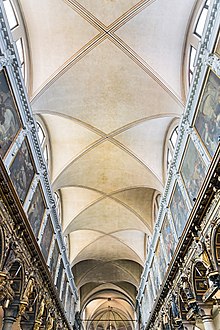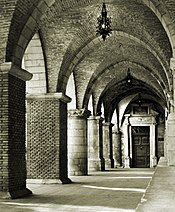Groin vault

Agroin vaultorgroined vault(also sometimes known as adouble barrel vaultorcross vault) is produced by the intersection atright anglesof twobarrel vaults.[1]The word "groin" refers to the edge between the intersecting vaults. Sometimes thearchesof groin vaults are pointed instead of round. In comparison with a barrel vault, a groin vault provides good economies of material and labor. Thethrustis concentrated along the groins orarrises(the four diagonal edges formed along the points where the barrel vaults intersect), so the vault need only beabuttedat its four corners.
Groin vault construction was first employed by theRomans,but then fell into relative obscurity in Europe until the resurgence of quality stone building brought about byCarolingianandRomanesque architecture.It was superseded by the more flexiblerib vaultsofGothic architecturein the laterMiddle Ages.Difficult to construct neatly because of the geometry of the cross groins (usually elliptical in cross section), the groin vault required great skill in cutting stone to form a neat arris. This difficulty, in addition to the formwork required to create such constructions, led to the rib vault superseding the groin vault as the preferred solution for enclosing space in Gothic architecture.[2]
The construction method was particularly common on thebasementlevel, such as atMyres CastleinScotland,or at the ground floor level for the storerooms as atMuchalls Castlein Scotland.[3]
History
[edit]While the barrel vault was more common than the groin vault in very earlyarchitecture,includingRomanand even earlier civilizations, the Romans developed the groin vault widely for applications in a variety of structures, some with significant span widths. The first groin vault inEuropewas, however, constructed inDelphiby KingAttalos IofPergamonsome time between 241 and 197 BC, quite possibly in 223 BC.[4]Their application of groin vaults to vast halls like thefrigidariain theBaths of CaracallaandDiocletianbecame highly influential in church architecture in theMiddle Ages.The aspirations ofchurchbuilding reached its zenith then, and the groin vault was pursued aggressively for its ability to create strength, without massivebuttressformations; in addition, it provided the church architects a remedy for the dimilluminationinherent in the barrel vault design, since the barrel vault had to minimisefenestrationto retain adequate strength.
20th-centurystructural engineershave studied the static stress forces of the groin vault design and validated the Romans' foresight in an efficient design to accomplish the multiple goals of minimum materials use, wide span of construction, ability to achieve lateral illumination, and avoidance of lateral stresses. A seminal modern design is the largestEuropeantrain station,HauptbahnhofinBerlin,which features an entrance building with a glass-spanned groin vault design.[5]
Comparison with other vault designs
[edit] |
 |
The construction of a groin vault can be understood most simply by visualising two barrel vault sections at right angles merging to form a squarish unit. The resulting four ribs convey the stress loading to the four corners, or piers.[6]The more complex groin vault is intrinsically a stronger design compared to thebarrel vault,since the barrel vault structure must rest on long walls creating less stable lateral stress, whereas the groin vault design can direct stresses almost purely vertically on the piers.[7]A common association of vaulting in cathedrals of the Middle Ages involves anaveof barrel vault design withtranseptsof groined vaulting.[8]Rib vaultsresemble groin vaults but introduce structural ribs running along the angles which carry much of the weight, making possible much greater variations of proportion.
Examples
[edit]
- Baths of Caracalla,Rome,Italy, early 3rd century AD 32.9 meter high groined structure[9]
- Charlemagne'sPalatine Chapel in Aachen,Germany
- Santa Maria Maggiore di Firenze,Florence,Italy, 11th-century church[10]
- Basilica of Sant'Ambrogio,Milan,Italy
- Old Cathedral of Coimbra,Coimbra,Portugal, lateral aisles, 12th century
- Muchalls Castle,Scotland,ground floor rooms from the 14th century
- All early Russian palaces, including thePalace of Facets(1487–91)
- Church of St. Triphon atIvan III's suburban estate of Naprudnoe, nearMoscow,1490s
- Three churches of theRostovkremlin,1670s and 1680s
- Exchange and Provost(Provost Dungeon),Charleston,South Carolina, 1771
- New Orleans Mint,New Orleans,Louisiana, 1838
- Aztec Center San Diego State,San Diego,California, 1968 now demolished.
- Basilica Minore de San Sebastiánin Quiapo, Manila, Philippines.
See also
[edit]References
[edit]- ^Honour, H.and J. Fleming, (2009)A World History of Art.7th edn. London: Laurence King Publishing, p. 949.ISBN978-1856695848
- ^"Concise Britannica".Archived fromthe originalon 2007-09-29.Retrieved2006-11-23.
- ^C.Michael Hogan,History of Muchalls Castle,Lumina Press, Aberdeen (2005)
- ^p. 94 in Boyd, T. D. 1978. "The Arch and Vault in Greek Architecture",American Journal of Archaeology82, 83–100.
- ^Schober, Hans (August 2006). "Berlin's recently completed Hauptbahnhof".Civil Engineering Magazine.
- ^Architectural comparison of various types of arch design
- ^Robert A. Scott,The Gothic Enterprise: A Guide to Understanding theMedievalCathedralUniversity of california Press (2003)
- ^Discussion of the Romanesque Conques, St. Faith Cathedral
- ^Leland M. Roth,Understanding Architecture: Its Elements, History and Meaning,Westview Press, Boulder, COISBN0-06-430158-3(1993)
- ^Guido Zucconi,Florence: An Architectural Guide,published by Arsenale Editrice, San Giovanni Lupatoto, Verona, Italy, November, 2001
